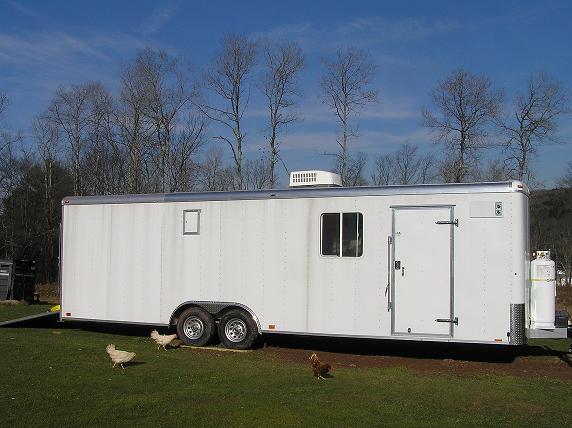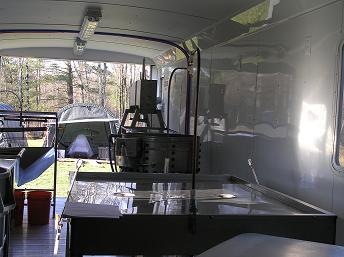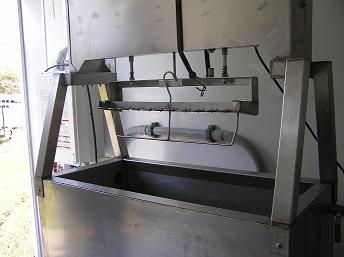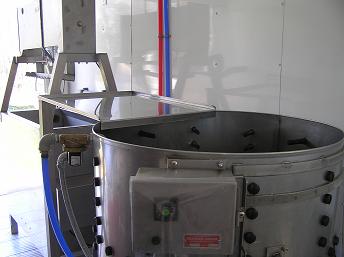UPDATE: SEPTEMBER 2012
Poultry farmer Ed Leonardi originally built this mobile poultry processing unit not only to process his own birds but to rent it out to other farmers, to process their birds under their own state license. In 2011, after several years of trying to make it work, he stopped offering services to other producers, because working with other small farmers didn’t pencil out. Not enough farmers were willing to pay a per-bird fee that covered Leonardi’s cash costs and the time required to work with multiple small farmers.
He now only processes his own birds: 3000 in 2012, with 5000 projected for 2013.
MPPU DESIGN CHANGES: Leonardi made significant design changes in 2010, based on what he had learned through operating it; see “plant design” section below.
Basic information
Capacity per day: 250–500 chickens a day (est. 6-8 people to process 500 birds)
Hours/day of operation: As needed (allowed to operate 24 hrs/day in NY state, as 5A licensing does not require state inspector to be present)
Days/week: As needed
Weeks/year: Currently seasonal, but could operate year round.
Species: poultry (chickens, pheasants, quail, and maybe turkeys)
Services: poultry slaughter and processing; guidance for farms in obtaining state license
Square feet: 238 sq. ft. (8.5 x 28 feet)
#/type of employees: none (run by owner)
Annual revenues: No data as yet; new operation
Price of services: $3/chicken and $8-15/turkey if MPPU owner does processing. If customers rent facility and do own processing, $1-1.50/chicken (quail/pheasant), $3.50-5/turkey. (Pricing may shift to flat fee/set-up fee basis.)
Operational costs: The customer supplies propane, electricity, and water. Propane use is estimated at 15 cents/chicken (30 gal. to heat water to process 700 chickens = 0.043 gal/chicken = 15 cents/chicken at Dec 2009 prices). The MPPU and generator use ~5 gal/day gasoline. The two-year 5A license costs $200.
Retail on-site: no
Wholesale: A 5A license holder may sell to restaurants, supermarkets, and distributors in NY state, but not across state lines.
Inspection: state of NY
Certified organic: not yet
Certification agency: n/a
Custom work: All work is custom (fee for service). (All is state inspected.)
Source verification on label: no
Looking into the MPPU from the back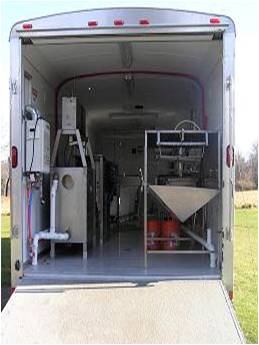
The market opportunity
In New York State, 5A license holders are allowed to process up to 20,000 birds of any species in a facility on their farm that meets all USDA slaughter and meat processing standards.
Pastured and other small-scale poultry producers have good market demand in New York but are constrained by the scarcity of state- and USDA-inspected processing facilities serving their sector. For instance, the poultry processing facility nearest to Ed Leonardi, owner of this MPPU, is located over 95 miles away but cannot be used to process poultry sold to restaurants or stores.
Poultry producers have several options: 1) Acquire or borrow equipment and operate as a custom-exempt processing plant under New York state’s 1,000 chicken/250 turkey exemption, which allows birds to be sold from the farm or at farmers’ markets, directly to the end-consumer, but not to restaurants or retail.) 2) Risk having another farm illicitly do the processing “under the table.” 3) Make a large investment to build a plant that meets the requirements for a 5A/USDA license.
The people/organizations involved
Ed Leonardi and Hudson Valley Poultry Processing, Inc.
History and development
When Ed Leonardi raised his first 25 chickens in 2005 as a beginning farmer, he was shocked to discover that processing (at $2.50 a bird) was the biggest expense of producing meat birds. “It’s virtually impossible to make a profit on birds with cost-prohibitive processing,” he explains.
As he grew his farming enterprise and began selling at Long Island farmers markets, Ed became more motivated to tackle the processing challenge. He did not want to be constrained by the state’s 1,000 chicken limit for plants exempt from inspection, yet he was not able or ready to invest in a costly permanent processing facility. In thinking through his options, he applied his background as a white-collar worker in sales, training, and human resources.
In October 2008 when he started designing his MPPU, he first obtained information from the NY State Department of Agriculture and Markets and told the agency he intended to develop the state’s first 5A-licensed MPPU. He established a relationship with the head inspector and got his drawings pre-approved so he could proceed.
Ed built the MPPU by retrofitting a new car transport trailer (made by Cargo Mate with a two-automobile capacity). To rustproof it, he had the manufacturer replace all steel in the trailer with aluminum at the factory. It also now weighs much less: about 4,300 lb. vs. 7,000 before replacing the steel. The ceiling is made of scratch-proof, non-porous vinyl.
Ed spent the next year “debugging it.” Under the 1,000 chicken/250 turkey state exemption, he used the MPPU to process all of his birds, and several other local poultry producers also used it.
Ed’s original plan was to hire a processing crew, but he decided instead to rent out the unit at a per day or per bird rate. This plan allowed him to meet his original goal of reducing the cost to producers for processing birds. It also allowed him, as the MPPU owner, to avoid overhead costs associated with employees, like Workers Compensation.
Funding sources
Ed self-financed the MPPU with cash. He initially tried to apply for grant funding but decided it wasn’t worth it. The grant program was for job creation and would have required him to hire one person for every $25,000 in funding. But he was trying to avoid having employees.
Business plan – How it works
The MPPU is owned by Hudson Valley Poultry Processing, Inc. and licensed by the state under its 5A program. Under this program, New York state inspectors approve the facility, but do not have to be present during slaughter or processing. (Producers could also use the MPPU to process less than 1,000 chickens under the state exemption, though this is not Ed’s target audience.)
Producers who obtain a 5A license will be eligible to rent the MPPU and process their own birds. Each license holder must have potable water and have it tested quarterly. A 5A license holder cannot use the MPPU to process other people’s birds.
The key to making the MPPU cost-effective, Ed says, is that producers will process the birds themselves. Otherwise processing in his MPPU would cost as much as going to any other poultry processing facility, and the only economic benefit would be not having to make a couple of round trips to a processing facility for every batch of birds.
Recognizing that pricing will be critical for retaining customers, Ed is considering volume discounts, such as $1.00-1.50/bird for the first 10,000; $0.75/bird for the next 10,001-15,000; and any additional at $0.50/bird.
One of his business strategies is to keep operating costs as low as possible, by requiring the MPPU users to provide the utilities (electricity, propane, and water), and such consumables as knives and an air compressor. They will also have the choice of paying for the trailer to be delivered or transporting it themselves, provided they have a vehicle capable of pulling it. They will also be required to clean and sanitize to his standards after using the MPPU.
Ongoing operational costs include basic maintenance and insurance. Most of the equipment is durable and should not need to be replaced for a long time. The picker motor, tank-less water heater, and pressure pump are consumables; replacing all these items would cost $3,000. The fee for a 5A license is $200 every two years. The MPPU is insured for its full-replacement value of $125,000 (theft and accident etc.).
To keep costs down, Ed did much of the construction himself, having taken night classes in carpentry, plumbing, electrical work, and related trades. By becoming a dealer of poultry processing equipment and negotiating purchases, he reduced the price of equipment considerably.
Ed estimates that he will recover his investment in the unit after the first 50,000 birds are processed. At that point, he intends to reinvest additional income from the unit in building 5 or more additional units to place in strategic locations around the state of New York. Eventually he is considering converting Hudson Valley Poultry Processing, Inc. into a non-profit or cooperative.
Ed’s business plan neither provides for his compensation as manager nor for the MPPU’s on-going operating expenses. He decided that the processing business needed to move forward right away, and paying himself in the beginning would force him to postpone construction of the next unit. He says he would rather reinvest the profit and “keep the momentum going.” Later when he has other units operating, he looks forward to a revenue stream.
In addition, he is interested in building a stationary USDA-inspected facility, once he has “a handle on where the most poultry are being processed.” He hopes to learn this by placing MPPUs in different parts of the state.
Deciphering regulations and complying
Ed started the design process by obtaining an information packet from the regulatory agency, NY State Department of Agriculture and Markets (NYSDAM), and telling the head inspector, Clarence Davis, about his plan to develop the state’s first 5A poultry MPPU. Ed had his plans pre-approved before starting construction.
After the MPPU was built, an inspector told him that only producers processing less than 1,000 chickens (or 250 turkeys) could use it. But when the inspectors showed up to see it, they couldn’t find any significant problems. (Just in case, Ed had two representatives from Cornell Cooperative Extension present during this first inspection.)
NYS DAM didn’t have any regulations pertaining to MPPUs, so the agency had to consult its legal department. It took months for the agency to put together protocols for the MPPU.
While the state has not required him to attend a HACCP training, Ed plans to do so. He is developing checklists, log forms, and protocols for producers to use when they rent the unit, and he intends to develop producer training program.
Water testing requirements–quarterly tests of potable water–are easy to meet. MPPU users also need to get approval from the NYS Department of Environmental Conservation or their local government jurisdiction for putting processing wastewater into their septic system.
Ed will require each farm that rents the MPPU to designate a person responsible for operating the unit. He is working on an MPPU certification program to train these designees, with re-certification every two years before the 5A license expires. Ideally he hopes to involve NYS DAM inspectors in the training.
Plant design
Ed’s primary consideration in designing the MPU was efficient workflow. He analyzed different processing systems to identify options that involve fewer steps and take less time and labor.
He opted for a killing tunnel that uses a 5-bird shackle, to stun and bleed five chickens at a time. There are five 5-bird shackles, so they can do 25 birds in 3-5 minutes; Ed finds this to take less time than using individual killing cones. The birds are not removed from the shackles until after they are scalded, an operation that takes approximately 28 seconds.
Ed feels strongly that all processing should take place inside the MPPU, rather than in a tent, yet he was originally concerned about the contamination potential of killing inside. He addressed this challenge with a killing tunnel to shield the rest of the MPPU from blood. Poultry transportation coops are always left outside for sanitary reasons.
In designing the MPPU to fit inside a trailer, Ed was able to reduce the required floor space by almost two-thirds of a typical small stationary plant. He eliminated space allocated to functions unnecessary in a mobile facility. His MPPU has no restroom (the processing workers must have access to one on site). It also lacks a walk-in cooler, storage area, office, and live bird area.
Typically a wall is required between the slaughter and evisceration areas, but Ed originally got a waiver for this. His concern was that since the MPPU only has two exits (at the front and back of the trailer), the dividing wall would e a safety issue and would be difficult to sanitize. To keep the areas separate, people working in the kill area wear red aprons, and those eviscerating wear white aprons. However, Ed added a half-wall in 2010 (see update below).
The equipment, mounted in brackets welded to the floor, is removable although it is all used inside the trailer. However if Ed were to decide not to continue using the MPPU, the trailer could easily be stripped and the equipment sold.
Equipment mounting bracket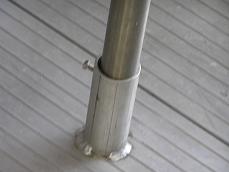
The final plant design requires each farm to provide utilities – propane, electricity, and potable water. Initially, the MPPU had a generator (100 amp) to supply electricity and two 100-lb. cylinders of propane (23.6 gal. each) provided on the front of the trailer.
However, the generator was too noisy, and electricity from the grid is cheaper. He installed a four-prong outlet on the exterior of the trailer and provides a 120-foot power cord. MPPU-users will have to install a four-prong 100 amp outlet on site.
Four-prong plug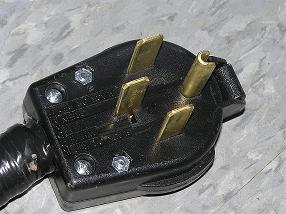
Eventually Ed will remove the generator. He is replacing the propane tanks with a quick connect on the trailer, and users will supply their own propane. Ed said fluctuations in the price of propane make it hard for him to include that cost accurately in his price structure.
DESIGN UPDATE (October 2010):
After nearly a year of operation, Ed made some design changes to the unit.
Two small additions were (1) a half wall, made of Lexan, to separate the clean area and the kill area and (2) a new hand-washing sink in the clean area. He is also thinking of installing a small shackle system over the evisceration table.
A much larger change, which has been approved by the state agriculture department, was the installation of a complete Vac-Air System for evisceration. Ed expects the new system to cut evisceration time by 70% – 85%.
“We had a bottleneck in evisceration because it was being done manually,” Ed explained. “We are trying to take the manual part out and put more automation in.” He now hopes to process at least 300-500 birds per day.
The Vac-Air equipment, primarily the Busch vacuum pump and the vacuum tank, had to be customized to fit in the MPPU; otherwise, the unit would no longer have been mobile.
Click here to see the updated MPPU layout and the Vac-Air drawing and equipment specs.
Big Glitches and how they were solved
Ed experienced several problems typical of building projects and made modifications to fix them.
His first picker had a defective motor and needed to be replaced. He believes using the picker with a generator as the power source caused circuits to pop, and he fixed the problem by hooking up to regular electric service. Ed had the trailer factory install the water intake line in the wrong spot. Once the unit was up and running he realized his mistake and installed a new water intake on the trailer in a better location. He also installed a pressure pump in the trailer to get 80 lb. pressure from his well.
Equipment required
The MPPU is outfitted with a shackle system and killing tunnel, dunker-scalder, picker, hand wash sink and double sink, evisceration table (that 6 people can stand around), quality assurance table, bagging table, and two USDA-approved chill tanks on wheels with sliding lids (made by Bonar Plastics). Ed has not needed ice for the chill tanks, as his well water is 38 degrees F. Hot water is provided with a Tagaki on-demand water heater. Setting this tankless water heater at its hottest temperature saves money on propane with the scalder. Additional equipment includes a pressure pump, two space heaters (electric and propane), and an air conditioner.
The processing functions like an assembly line, with the slowest operation being evisceration. Birds are killed, bled, picked, chilled and eviscerated, chilled, bagged, weighed, and labeled. Ed uses a CAS LP-1000N label printing scale and has a label with required food safety information pre-printed for producers to use.)
As noted above, he chose the shackle/killing tunnel system for efficiency, as it allows 5 chickens to be removed from the killing tunnel at the same time. The birds stay attached to the 5-bird shackle for dunking and scalding. Ed prefers the design of his dunker-scalder over newer models that spin instead of dunk the birds. He says it’s “a real time saver and provides a better scald.” Also the dunker-scalder has no motor to burn out but instead requires an air compressor.
The MPPU is outfitted with Pickwick Knase processing equipment: the 5-bird shackle/kill tunnel, dunker-scalder, and plucker. He had three reasons for selecting this company, which is a high-end stainless steel fabricator and the oldest of the poultry processing equipment manufacturers he considered. (1) Their equipment is USDA approved. (2) It makes more efficient use of labor and thus saves time. (Working in a software department, he learned to count keystrokes.) And finally, (3) he promised to use only Pickwick Knase equipment if he could be a dealer, and the company agreed.
Customers supply the following: an air compressor for the dunker-scalder that supplies 120 psi air pressure from a source rated 2.3-4 acfm at 70 psi such as a ¾ or 1hp portable air compressor (costs ~$100-125 new); propane; a four-pronged electric outlet for a shoreline to power the MPU; a potable water source; access to a septic tank (approved for disposal by the state or local government); and a level gravel pad for parking. The MPPU supplies the propane quick connect hook-up and a regulator, a water hose to the farm site’s water source, and the electric port for service to the unit.
Staff needed, how they were found and trained, and what they cost
The MPPU has no employees.
Financial sustainability plan
Owning the MPPU has already saved Ed money and increased the profitability of his own poultry production enterprise by allowing him to process his birds on his farm. Otherwise he must pay about $3 per chicken plus transportation time and expenses.
Ed’s goal for this first MPPU is to process 30,000 birds per year, which would require 10 customers processing 3,000 birds a year. If the unit were to process only 10,000 birds a year at $1 a bird, he would recover his investment in just 5.5 years. This rate works out to less than 500 birds processed a week for 26 weeks.
As noted above, once this MPPU is paid for, Ed plans to use additional revenues to finance more MPPUs, aiming for five or more in New York state.
As entrepreneurs often do, Ed has deferred profit and management compensation to the future; they both depend on the growth of the business, with more MPPUs operating.
Keeping cash flowing and people busy during seasonal slow times
Ed’s business model does not require the MPPU to operate during the winter and most of the spring. It is easily winterized by draining the water lines.
Markets accessed
Finding users seems to be Ed’s main challenge. Among his potential customers for 2010 are two nearby poultry producers who are raising or have the potential to raise far more than 1,000 birds per year. Ideally he would like to have about 10 customers, each producing an average of 3,000 birds a year.
Lessons learned
Relying on a generator for electricity was a mistake. It was too loud to carry out a normal conversation (a safety consideration around machinery and knives) and expensive to run. The solution is to require users to install a 100-amp service outlet at their site prior to using the MPPU.
Similarly, instead of providing propane on the MPU, customers will be required to supply their own.
Ed found that he will have to require customers to have a level pad for parking the MPU trailer. He also discovered the importance of visiting farms before agreeing to bring the MPPU to them. Driveway clearance is one reason.

